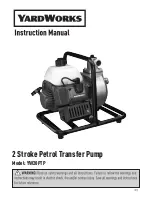
For parts or assistance, call Diamond Customer Service at
1-800-265-7241
Installation / Operation
4
4. Install an in-line check valve to prevent flow back-
wards through pump when pump shuts off.
NOTICE:
Drill a 1/8" (3.2 mm) hole in discharge pipe
just above pump body but below check valve to pre-
vent air locks.
5. Install discharge plumbing. A 1-1/4” FNPT to 1-1/4”
FNPT adapter is included with the pump. Use rigid
plastic pipe and wrap threads with Teflon tape. Screw
pipe into pump hand tight +1 – 1-1/2 turns.
Risk of flooding.
If a flexible discharge
hose is used, make sure pump is secured in sump to
prevent movement. Failure to secure pump may
allow pump movement, switch interference and pre-
vent pump from starting or stopping.
6. To reduce motor noise and vibrations, a short length
of rubber hose (1-7/8" (47.6mm) I.D., e.g. radiator
hose) can be connected into discharge line near
pump using suitable clamps.
7. Power Supply: Pump is designed for 115 V., 60 Hz.,
operation and requires a minimum 15 amp individual
branch circuit. Both pump and switch are supplied
with 3-wire cord sets with grounding-type plugs.
Switch plug is inserted directly into outlet and pump
plug inserts into opposite end of switch plug.
Hazardous voltage. Can shock, burn or
kill.
Pump should always be electrically grounded to
a suitable electrical ground such as a grounded water
pipe or a properly grounded metallic raceway, or
ground wire system. Do not cut off ground pin.
8. If pump discharge line is exposed to outside sub-
freezing atmosphere, portion of line exposed must be
installed so any water remaining in pipe will drain to
the outfall by gravity. Failure to do this can cause
water trapped in discharge line to freeze which could
result in damage to pump.
9. After piping and check valve have been installed, unit
is ready for operation.
10. Check operation by filling sump with water and
observing pump operation through one complete
cycle.
Risk of flooding.
Failure to make this
operational check may lead to improper operation,
premature failure, and flooding.
OPERATION
Risk of electric shock. Can burn or kill.
Before attempting to check why unit has stopped operat-
ing, disconnect power from unit. Do not handle a pump
or pump motor with wet hands or when standing on wet
or damp surface, or in water.
1. Shaft seal depends on water for lubrication. Do not
operate pump unless it is submerged in water as seal
may be damaged if allowed to run dry.
2. Motor is equipped with an automatic reset thermal
protector. If temperature in motor should rise unduly,
switch will cut off all power before damage can be
done to motor. When motor has cooled sufficiently,
switch will reset automatically and restart motor. If
protector trips repeatedly, pump should be removed
and checked as to cause of difficulty. Low voltage,
extension cords, clogged impeller, very low head or
lift, etc., could cause cycling.
3. Pump will not remove all water.






























